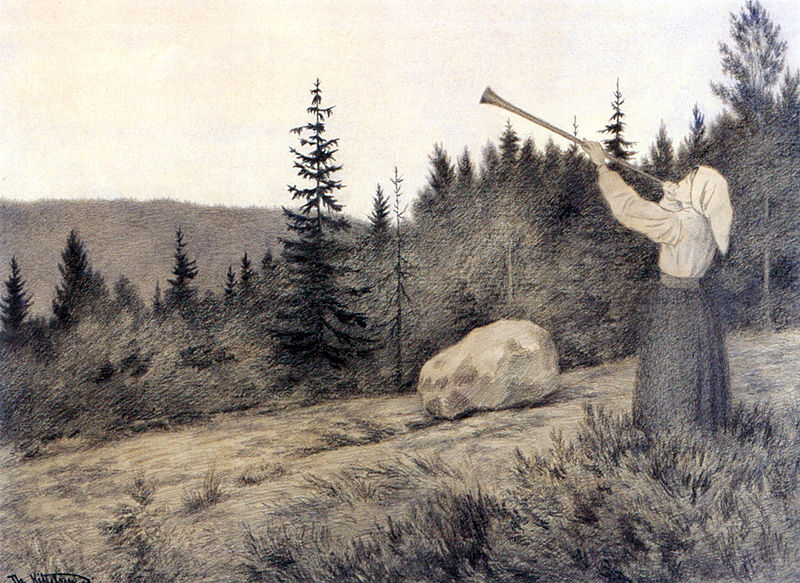"When night falls
she cloaks the world
in impenetrable darkness.
A chill rises
from the soil
and contaminates the air.
Suddenly
life has new meaning."
Much has been written about Burzum and this Norweigan Black Metal project's sole member Varg Vikernes aka Count Grishnackh, including the improbable description of him being "the most notorious metal musician of all time".* Vikernes is a murderer, an arsonist of beautiful historic wooden churches, and a white supremicist. I am not going to forgive him any of these terrible things, but I am not going to make it the focus of this post. Often the traits that make an artist appealing are the same traits that make them unbearable as a person.
I have long been attracted to the imagery created in the lyrics and album artwork of Burzum, ever since some time in the mid 1990s when I bought a hardback book-size copy of the album Filosofem based solely on rumour I had picked up from Kerrang! and Metal Hammer magazines and the magic of the cover artwork. I had no real idea of what Black Metal was, nor was I even aware of any sorts of noise, drone or dark ambient styles. I was completely unprepared for the music. This was even before I got into Pink Floyd so I had no experience of 25 minute long songs, but was instantly drawn in by song titles like Jesus' Tod, Erblicht Die Töchter Des Firmaments, and Rundgang Um Die Transzendentale Säule Der Singularität.
Anyone who knows anything about Burzum, whether they agree with it or not, knows the received wisdom is that Dunkleheit, whose lyrics open this blog post, is the perfect Burzum song. Like the painter Jean Michel Basquiat's masterpiece Riding With Death, Dunkleheit "achieves a sparsity and clarity of technique possibly greater than in any other work". Reportedly the guitar was recorded using a home stereo as an amplifier and the vocals were recorded using the studio's "worst microphone," a headset not intended for recording quality. The distortion on the guitar is so heavy as to create a sound almost like white noise, which is underpinned by the slow pulsing wump-pah of the most basic rock drums.
The lyrics are haiku-like in their subtle perfect invocation of season, atmosphere and ephiphany. Something intangible is observed, and "suddenly, life has new meaning". Rarely have I seen or heard a set of song lyrics that stand up so well when removed from the context of the music. Try reading some lyrics by Jay-Z or Kanye West; they may sound cool, but when read reveal themselves to be meaningless bollocks – a string of non-sequiters and brand names. (Aside: the album version of Diamonds from Sierra Leone had an incredibly thoughtful verse by Kanye which was replaced by more nonsense for the single release. My favourite Kanye song is Never Let Me Down; the best verse on this is by a poet called J. Ivy.)
 |
| Op under Fjeldet toner en Lur, Theodor Kittelsen |
The cover of Filosofem features an infinitely evocotive illustration by a not-well-known-enough Norweigan artist called Theodor Kittelsen; Op under Fjeldet toner en Lur – "Up in the hills a clarion call rings out". I could look at this picture from now until the cobwebs obscured my sight. All of Burzum's albums have wonderful cover art, some of which uses Kittelsen illustrations, others are from other sources, e.g. early album Aske ("Ashes") has a photograph of the burnt remains of the Fantoft Stave Church (Vikernes himself was strongly suspected of the arson attack), and most recent album Fallen has a beautiful painting by French realist William-Adolphe Bouguereau.
Now let's enjoy a video and some artwork:
.jpg/488px-Theodor_Kittelsen_-_Pesta_i_trappen,_1896_(Pesta_on_the_Stairs).jpg) |
| Plague on the Stairs, Theodor Kittelsen |
.jpg/485px-Theodor_Kittelsen_-_Fattigmannen,_1894-95_(The_Pauper).jpg) |
| The Pauper, Theodor Kittelsen |
_-_The_Wave_(1896).jpg/794px-William-Adolphe_Bouguereau_(1825-1905)_-_The_Wave_(1896).jpg) |
| The Wave, William-Adolphe Bouguereau |
No comments:
Post a Comment